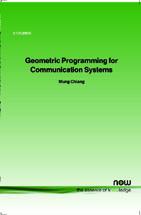Geometric Programming for Communication Systems
By Mung Chiang, Princeton University, USA, chiangm@princeton.edu
Abstract
Geometric Programming (GP) is a class of nonlinear optimization with many useful theoretical and computational properties. Over the last few years, GP has been used to solve a variety of problems in the analysis and design of communication systems in several 'layers' in the communication network architecture, including information theory problems, signal processing algorithms, basic queuing system optimization, many network resource allocation problems such as power control and congestion control, and cross-layer design. We also start to understand why, in addition to how, GP can be applied to a surprisingly wide range of problems in communication systems. These applications have in turn spurred new research activities on GP, especially generalizations of GP formulations and development of distributed algorithms to solve GP in a network. This text provides both an in-depth tutorial on the theory, algorithms, and modeling methods of GP, and a comprehensive survey on the applications of GP to the study of communication systems.
Geometric Programming for Communication Systems
Recently, Geometric Programming has been applied to study a variety of problems in the analysis and design of communication systems from information theory and queuing theory to signal processing and network protocols.
Geometric Programming for Communication Systems begins its comprehensive treatment of the subject by providing an in-depth tutorial on the theory, algorithms, and modeling methods of Geometric Programming. It then gives a systematic survey of the applications of Geometric Programming to the study of communication systems. It collects in one place various published results in this area, which are currently scattered in several books and many research papers, as well as up-to-date unpublished results.
Geometric Programming for Communication Systems is intended for researchers and students who wish to have a comprehensive star ting point for understanding the theory and applications of geometric programming in communication systems.
